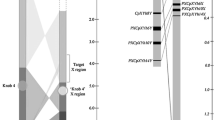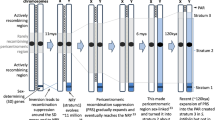Abstract
Sex chromosomes are a pair of specialized chromosomes containing a sex determination region that is suppressed for recombination. Without recombination, Y chromosomes are thought to accumulate repetitive DNA sequences which contribute to their degeneration. A pair of primitive sex chromosomes controls sex type in papaya with male and hermaphrodite determined by the slightly different male-specific region of the Y (MSY) and hermaphrodite-specific region of Yh (HSY) chromosomes, respectively. Here, we show that the papaya HSY and MSY in the absence of recombination have accumulated nearly 12 times the amount of chloroplast-derived DNA than the corresponding region of the X chromosome and 4 times the papaya genome-wide average. Furthermore, a chloroplast genome fragment containing the rsp15 gene has been amplified 23 times in the HSY, evidence of retrotransposon-mediated duplication. Surprisingly, mitochondria-derived sequences are less abundant in the X and HSY compared to the whole genome. Shared organelle integrations are sparse between X and HSY, with only 11 % of chloroplast and 12 % of mitochondria fragments conserved, respectively, suggesting that the accelerated accumulation of organelle DNA occurred after the HSY was suppressed for recombination. Most of the organelle-derived sequences have divergence times of <7 MYA, reinforcing this notion. The accumulated chloroplast DNA is evidence of the slow degeneration of the HSY.



Similar content being viewed by others
References
Altschul SF, Gish W, Miller W, Myers EW, Lipman DJ (1990) Basic local alignment search tool. J Mol Biol 215:403–410
Bachtrog D (2003) Adaptation shapes patterns of genome evolution on sexual and asexual chromosomes in Drosophila. Nat Genet 34:215–219
Bachtrog D, Charlesworth B (2002) Reduced adaptation of a non-recombining neo-Y chromosome. Nature 416:323–326
Bergero R, Charlesworth D (2009) The evolution of restricted recombination in sex chromosomes. Trends Ecol Evol 24:94–102
Bromham L, Penny D (2003) The modern molecular clock. Nat Rev Genet 4(3):216–224
Erlandsson R, Wilson JF, Paabo S (2000) Sex chromosomal transposable element accumulation and male-driven substitutional evolution in humans. Mol Biol Evol 17:804–812
Grant SA, Houben A, Vyskot B, Siroky J, Pan WH, Macas J, Saedler H (1994) Genetics of sex determination in flowering plants. Dev Genet 15:214–230
Huang CY, Ayliffe MA, Timmis JN (2003) Direct measurement of the transfer rate of chloroplast DNA into the nucleus. Nature 422:72–76
Jukes TH, Cantor CR (1969) Evolution of protein molecules. In: Munro HN (ed) Mammalian protein metabolism. Academic Press, New York, pp 21–132
Kejnovsky E, Kubat Z, Hobza R, Lengerova M, Sato S, Tabata S, Fukui K, Matsunaga S, Vyskot B (2006) Accumulation of chloroplast DNA sequences on the Y chromosome of Silene latifolia. Genetica 128:167–175
Koch MA, Haubold B, Mitchell-Olds T (2000) Comparative evolutionary analysis of chalcone synthase and alcohol dehydrogenase loci in Arabidopsis, Arabis, and related genera (Brassicaceae). Mol Biol Evol 17(10):1483–1498
Krzywinski M, Schein J, Birol I, Connors J, Gascoyne R, Horsman D, Jones SJ, Marra MA (2009) Circos: an information aesthetic for comparative genomics. Genome Res 19:1639–1645
Leister D (2005) Origin, evolution and genetic effects of nuclear insertions of organelle DNA. Trends Genet 21:655–663
Li WH (1997) Molecular evolution. Sinauer Associates, Inc., Sunderland
Lin X, Kaul S, Rounsley S et al (1999) Sequence analysis of chromosome 2 of the plant Arabidopsis thaliana. Nature 402:761–768
Liu Z, Moore PH, Ma H, Ackerman CM, Ragiba M, Yu Q, Pearl HM, Kim MS, Charlton JW, Stiles JI, Zee FT, Paterson AH, Ming R (2004) A primitive Y chromosome in papaya marks incipient sex chromosome evolution. Nature 427:348–352
Matsuo M, Ito Y, Yamauchi R, Obokata J (2005) The rice nuclear genome continuously integrates, shuffles, and eliminates the chloroplast genome to cause chloroplast–nuclear DNA flux. Plant Cell 17:665–675
Mourier T, Hansen AJ, Willerslev E, Arctander P (2001) The Human Genome Project reveals a continuous transfer of large mitochondrial fragments to the nucleus. Mol Biol Evol 18:1833–1837
Muller HJ (1964) The relation of recombination to mutational advance. Mutat Res 106:2–9
Na JK, Wang J, Murray JE, Gschwend AR, Zhang W, Yu Q, Navajas-Perez R, Feltus FA, Chen C, Kubat Z, Moore PH, Jiang J, Paterson AH, Ming R (2012) Construction of physical maps for the sex-specific regions of papaya sex chromosomes. BMC Genomics 13(1):176
Nugent JM, Palmer JD (1991) RNA-mediated transfer of the gene coxII from the mitochondrion to the nucleus during flowering plant evolution. Cell 66:473–481
Okada S, Sone T, Fujisawa M, Nakayama S, Takenaka M et al (2001) The Y chromosome in the liverwort Marchantia polymorpha has accumulated unique repeat sequences harboring a male-specific gene. Proc Natl Acad Sci USA 98:9454–9459
Ossowski S, Schneeberger K, Lucas-Lledo JI, Warthmann N, Clark RM et al (2010) The rate and molecular spectrum of spontaneous mutations in Arabidopsis thaliana. Science 327:92–94
Ricchetti M, Fairhead C, Dujon B (1999) Mitochondrial DNA repairs double strand breaks in yeast chromosomes. Nature 402:96–100
Ricchetti M, Tekaia F, Dujon B (2004) Continued colonization of the human genome by mitochondrial DNA. PLoS Biol 2:1313–1324
Rice Chromosome 10 Sequencing Consortium (2003) In-depth view of structure, activity, and evolution of rice chromosome 10. Science 300:1566–1569
Richly E, Leister D (2004) NUMTs in sequenced eukaryotic genomes. Mol Biol Evol 21:1081–1084
Sakamoto K, Ohmido N, Fukui K, Kamada H, Satoh S (2000) Site-specific accumulation of a LINE-like retrotransposon in a sex chromosome of the dioecous plant Cannabis sativa. Plant Mol Biol 44:723–732
Steinemann M, Steinemann S (1992) Degenerating Y chromosome of Drosophila miranda: a trap for retrotransposons. Proc Natl Acad Sci USA 89:7591–7595
Stupar RM, Lilly JW, Town CD, Cheng Z, Kaul S, Buell CR, Jiang J (2001) Complex mtDNA constitutes an approximate 620-kb insertion on Arabidopsis thaliana chromosome 2: implication of potential sequencing errors caused by large-unit repeats. Proc Natl Acad Sci USA 98:5099–5103
Timmis JN, Ayliffe MA, HuangY Martin W (2004) Endosymbiotic gene transfer: organelle genomes forge eukaryotic chromosomes. Nature Rev Genet 5:123–135
Wang J, Na JK, Yu Q et al (2012) Sequencing papaya X and Yh chromosomes reveals molecular basis of incipient sex chromosome evolution. Proc Nat Ac Sci USA 109:13710–13715
Weingartner LA, Moore RC (2012) Contrasting patterns of X/Y polymorphism distinguish Carica papaya from other sex-chromosome systems. Mol Biol Evol. doi:10.1093/molbev/mss196
Westergaard M (1958) The mechanism of sex determination in dioecious flowering plants. Adv Genet 9:217–281
Yamato KT, Ishizaki K, Fujisawa M, Okada S, Nakayama S et al (2007) Gene organization of the liverwort Y chromosome reveals distinct sex chromosome evolution in a haploid system. Proc Natl Acad Sci USA 104:6472–6477
Zhang L, Vision TJ, Gaut BS (2002) Patterns of nucleotide substitution among simultaneously duplicated gene pairs in Arabidopsis thaliana. Mol Biol Evol 19:1464–1473
Acknowledgments
This work was supported by grants from the National Science Foundation (NSF) Plant Genome Research Program to RM (Award Nos. DBI0553417; DBI-0922545).
Author information
Authors and Affiliations
Corresponding author
Additional information
Communicated by D. Tian.
Electronic supplementary material
Below is the link to the electronic supplementary material.
Rights and permissions
About this article
Cite this article
VanBuren, R., Ming, R. Organelle DNA accumulation in the recently evolved papaya sex chromosomes. Mol Genet Genomics 288, 277–284 (2013). https://doi.org/10.1007/s00438-013-0747-7
Received:
Accepted:
Published:
Issue Date:
DOI: https://doi.org/10.1007/s00438-013-0747-7




